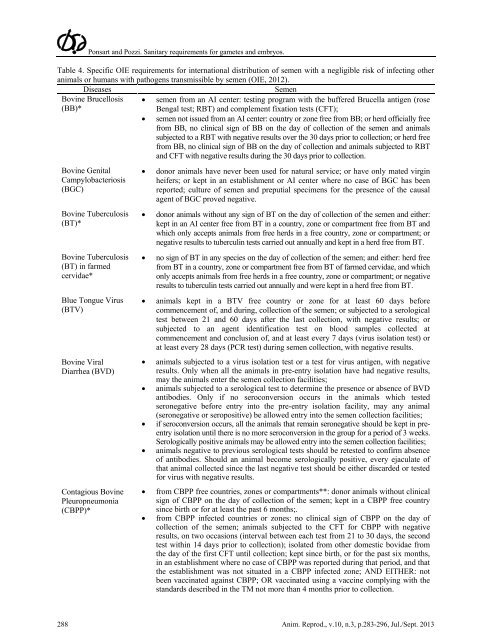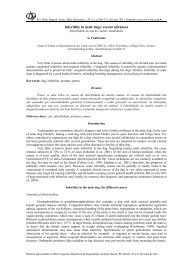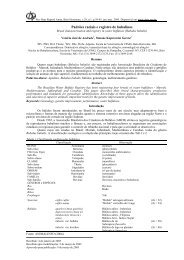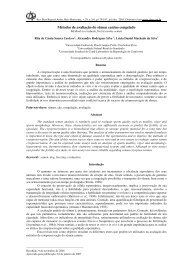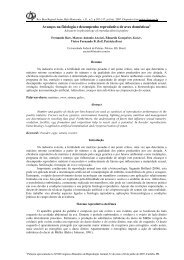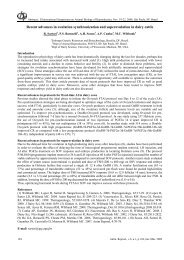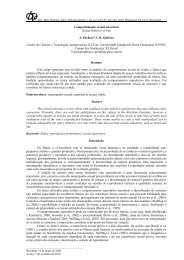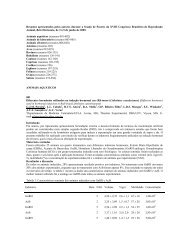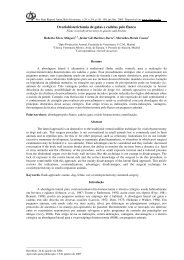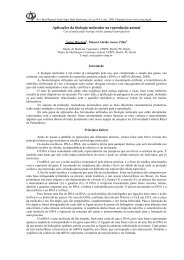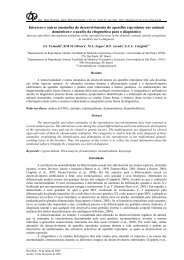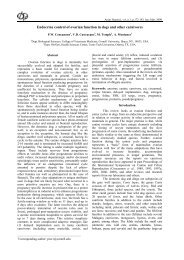Sanitary requirements for bovine gametes and embryos in ... - CBRA
Sanitary requirements for bovine gametes and embryos in ... - CBRA
Sanitary requirements for bovine gametes and embryos in ... - CBRA
Create successful ePaper yourself
Turn your PDF publications into a flip-book with our unique Google optimized e-Paper software.
Ponsart <strong>and</strong> Pozzi. <strong>Sanitary</strong> <strong>requirements</strong> <strong>for</strong> <strong>gametes</strong> <strong>and</strong> <strong>embryos</strong>.Table 4. Specific OIE <strong>requirements</strong> <strong>for</strong> <strong>in</strong>ternational distribution of semen with a negligible risk of <strong>in</strong>fect<strong>in</strong>g otheranimals or humans with pathogens transmissible by semen (OIE, 2012).DiseasesSemenBov<strong>in</strong>e Brucellosis(BB)*• semen from an AI center: test<strong>in</strong>g program with the buffered Brucella antigen (roseBengal test; RBT) <strong>and</strong> complement fixation tests (CFT);• semen not issued from an AI center: country or zone free from BB; or herd officially freefrom BB, no cl<strong>in</strong>ical sign of BB on the day of collection of the semen <strong>and</strong> animalssubjected to a RBT with negative results over the 30 days prior to collection; or herd freefrom BB, no cl<strong>in</strong>ical sign of BB on the day of collection <strong>and</strong> animals subjected to RBT<strong>and</strong> CFT with negative results dur<strong>in</strong>g the 30 days prior to collection.Bov<strong>in</strong>e GenitalCampylobacteriosis(BGC)Bov<strong>in</strong>e Tuberculosis(BT)*Bov<strong>in</strong>e Tuberculosis(BT) <strong>in</strong> farmedcervidae*Blue Tongue Virus(BTV)Bov<strong>in</strong>e ViralDiarrhea (BVD)Contagious Bov<strong>in</strong>ePleuropneumonia(CBPP)*• donor animals have never been used <strong>for</strong> natural service; or have only mated virg<strong>in</strong>heifers; or kept <strong>in</strong> an establishment or AI center where no case of BGC has beenreported; culture of semen <strong>and</strong> preputial specimens <strong>for</strong> the presence of the causalagent of BGC proved negative.• donor animals without any sign of BT on the day of collection of the semen <strong>and</strong> either:kept <strong>in</strong> an AI center free from BT <strong>in</strong> a country, zone or compartment free from BT <strong>and</strong>which only accepts animals from free herds <strong>in</strong> a free country, zone or compartment; ornegative results to tubercul<strong>in</strong> tests carried out annually <strong>and</strong> kept <strong>in</strong> a herd free from BT.• no sign of BT <strong>in</strong> any species on the day of collection of the semen; <strong>and</strong> either: herd freefrom BT <strong>in</strong> a country, zone or compartment free from BT of farmed cervidae, <strong>and</strong> whichonly accepts animals from free herds <strong>in</strong> a free country, zone or compartment; or negativeresults to tubercul<strong>in</strong> tests carried out annually <strong>and</strong> were kept <strong>in</strong> a herd free from BT.• animals kept <strong>in</strong> a BTV free country or zone <strong>for</strong> at least 60 days be<strong>for</strong>ecommencement of, <strong>and</strong> dur<strong>in</strong>g, collection of the semen; or subjected to a serologicaltest between 21 <strong>and</strong> 60 days after the last collection, with negative results; orsubjected to an agent identification test on blood samples collected atcommencement <strong>and</strong> conclusion of, <strong>and</strong> at least every 7 days (virus isolation test) orat least every 28 days (PCR test) dur<strong>in</strong>g semen collection, with negative results.• animals subjected to a virus isolation test or a test <strong>for</strong> virus antigen, with negativeresults. Only when all the animals <strong>in</strong> pre-entry isolation have had negative results,may the animals enter the semen collection facilities;• animals subjected to a serological test to determ<strong>in</strong>e the presence or absence of BVDantibodies. Only if no seroconversion occurs <strong>in</strong> the animals which testedseronegative be<strong>for</strong>e entry <strong>in</strong>to the pre-entry isolation facility, may any animal(seronegative or seropositive) be allowed entry <strong>in</strong>to the semen collection facilities;• if seroconversion occurs, all the animals that rema<strong>in</strong> seronegative should be kept <strong>in</strong> preentryisolation until there is no more seroconversion <strong>in</strong> the group <strong>for</strong> a period of 3 weeks.Serologically positive animals may be allowed entry <strong>in</strong>to the semen collection facilities;• animals negative to previous serological tests should be retested to confirm absenceof antibodies. Should an animal become serologically positive, every ejaculate ofthat animal collected s<strong>in</strong>ce the last negative test should be either discarded or tested<strong>for</strong> virus with negative results.• from CBPP free countries, zones or compartments**: donor animals without cl<strong>in</strong>icalsign of CBPP on the day of collection of the semen; kept <strong>in</strong> a CBPP free countrys<strong>in</strong>ce birth or <strong>for</strong> at least the past 6 months;.• from CBPP <strong>in</strong>fected countries or zones: no cl<strong>in</strong>ical sign of CBPP on the day ofcollection of the semen; animals subjected to the CFT <strong>for</strong> CBPP with negativeresults, on two occasions (<strong>in</strong>terval between each test from 21 to 30 days, the secondtest with<strong>in</strong> 14 days prior to collection); isolated from other domestic bovidae fromthe day of the first CFT until collection; kept s<strong>in</strong>ce birth, or <strong>for</strong> the past six months,<strong>in</strong> an establishment where no case of CBPP was reported dur<strong>in</strong>g that period, <strong>and</strong> thatthe establishment was not situated <strong>in</strong> a CBPP <strong>in</strong>fected zone; AND EITHER: notbeen vacc<strong>in</strong>ated aga<strong>in</strong>st CBPP; OR vacc<strong>in</strong>ated us<strong>in</strong>g a vacc<strong>in</strong>e comply<strong>in</strong>g with thest<strong>and</strong>ards described <strong>in</strong> the TM not more than 4 months prior to collection.288 Anim. Reprod., v.10, n.3, p.283-296, Jul./Sept. 2013


